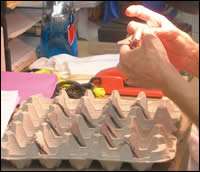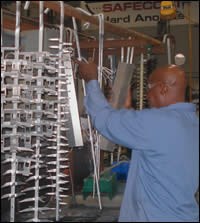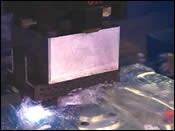Plater Finds A Niche In The Medical Plating Market
Appears in Print as: 'Risks and Rewards '
The medical plating market is not for everyone
#medical #pollutioncontrol #economics
Most smart finishing shop managers will tell you they look for niches where they can either dominate or where they can bid on jobs that might produce better margins than more run-of-the-mill work. The medical industry certainly offers such opportunities for those willing to make the investment in time, effort and money it takes to get established with large medical OEMs and their suppliers.
One company that has successfully done that is the Electrolizing Corporation of Ohio (Electrohio, Cleveland). In business since 1948, the company has been involved in medical plating and other medical surface finishing since the late 1980s, and currently operates two plants on Cleveland’s east side.
Featured Content
Electrohio’s Ray Harris says medical finishing represents about half of the company’s business. “The medical market is extremely broad—everything from equipment like hospital beds or wheelchairs to clean room packaging, sterilization equipment, instruments and implants. It’s huge.”
Getting Started
Electrohio launched its medical plating business after its engineers developed a proprietary electroplating process called MedCoat (see sidebar). According to Harris, the coating is applicable mainly for surgical instruments, although Electrohio applies it to a variety of medical and non-medical parts. “It’s an extremely durable coating that is hard and lubricious and can withstand autoclave sterilization,” he says. “We basically took traditional hard chrome and changed the chemistry and changed the way we apply it.”
One issue the company recently faced with MedCoat: it is a hexavalent chromium process, and bringing facilities into compliance with drastically lower permissible exposure limits for hex chrome cost Electrohio a substantial amount of money.
But MedCoat is not the only process at Electrohio that is aimed mainly at medical applications. The company also performs Type II and Type III aluminum anodizing, Type II titanium anodizing, colored titanium anodizing, electroless nickel plating, stainless and titanium electropolishing and passivation processes in a total of 37,000 sq ft of floor space. The company has plans for secondary operations that will include laser engraving— a requirement for indicating size and other information on many medical components.
Electrohio got some help on the laser front from one of its sister companies, and general manager Bill Loucks says the assistance also extends to other areas, including testing and metallurgy. “We’re quite a bit bigger than a lot of shops,” he says. “We have about 60 employees in Electrolizing, and with our sister companies there are upwards of 500 employees. One of our sister companies is one of the largest laser contract manufacturers in the world. The size of our organization also helped us invest in chemists, metallurgists and other experts that a lot of plating shops don’t have.”
The Process
Electrohio moves a lot of parts through its processes. Several years ago the company implemented lean manufacturing techniques that allowed it to reduce lead times. In 2004 and 2005, Electrohio experienced more than 70% growth in sales, yet still maintained the same size work force and lowered average lead times.
Most jobs are in-house 24–48 hr, and the process begins with receiving inspection, something Harris says is especially important for medical components.
“When parts come in the door, we immediately inspect them,” Harris says. “For medical parts, we lay them out and look at them. If there are nicks and dings already on the parts, we don’t touch them, because if we plate those parts we just bought them.
“So we let customers know if there’s an issue, and ask them what they want us to do—sort the parts, plate them as is, send them back or use an additional process.”
Another requirement before parts are released for processing is knowing not only the material but also the metallurgical condition. “If we don’t know the alloy and heat treatment, we won’t touch them,” Harris says. “Some parts, for example, need to be baked either before or after chrome plating, or both, to avoid any potential for hydrogen embrittlement. So that’s why it’s critical for us to know exactly what we are dealing with.”
Parts are also counted, and they may be examined under magnification. Next comes a check of paperwork, and all purchase orders, routers, and other process documentation must be in order before the job is released.
Processing is mainly on manual rack lines. The company operates large tanks, but may use multiple rectifiers and other equipment to divide tanks into plating cells that allow them to run more than one job simultaneously.
Bath chemistry control is achieved via manual additions on a regular schedule. The company uses an atomic absorption spectrometer for on-site bath analysis, and also sends samples to outside labs on a monthly basis. Lab personnel also handle waste treatment and EPA/OSHA compliance verification.
According to Harris, process control is especially critical in titanium anodizing operations, where the thickness and microstructure of the oxide layer produced govern the color of the finished product. “Color is extremely important,” he says. “In many medical applications, for example, different size components are coded by color to make things as easy as possible for the surgeon during surgery. Colors must be within a tight range to avoid confusing the surgeon. This requires extreme process control.”
“For aluminum anodizing, dyeing is a major component,” he continues. “Titanium anodizing doesn’t work that way. Essentially, the thickness and microstructure of the oxide layer on a titanium part change how light reflects off the part, so your eye perceives different colors.” Electrohio can produce titanium anodized parts in a range of colors, he adds.
Medical Quality
In-process quality checks for medical jobs include running test coupons with production parts. The coupons are sent to an outside lab for a battery of tests including adhesion and hardness. Once a job is complete, final inspection may include X-ray thickness testing, dimensional checks and other quality measures.
Beyond process control, finishes on medical devices also must be tested for compatibility with blood and tissue. Biocompatibility testing requires a big commitment in both time and money, according to Harris.
“We are trying to get companies to buy our products that will be implanted in the body or used in surgery, and be in contact with tissue and blood,” he says. “The amount of testing you need to go through up front is substantial. It can take years.
“There are generally three stages of biocompatibility testing,” he continues. “The first couple are relatively simple, but the third stage is actual clinical testing using animals. That’s where you get into the money, because you need a lab that will monitor the animals every day and do all the required tests. That might take months.”
According to Harris, biocompatibility testing is performed according to various ISO standards. The biocompatibility book for Medcoat 2000, for example, is a 12-part document covering everything from tests for genotoxicity, carcinogenicity, cytotoxicity and reproductive toxicity to tests for local effects after implantation.
“The standards have multiple levels of testing for instruments, implants, cardiovascular devices, and other types of products. The testing required for instruments, for example is less stringent than that needed for an implant that might reside in the body for years.”
Not only is testing expensive, Harris says, but many customers want Electrohio to perform it for them. “There are two routes: spend the money and do the testing up front, or say to your customers, ‘Here’s the product, do the testing yourself.’ The second one doesn’t work all the time.”
New products, in particular, take considerable time to develop and test, and Loucks says there’s a chance his company may never see revenue in such situations. “For new products, customers want some samples to test, and they generally don’t want to pay for them. So they do some initial testing, then they do some biocompatibility testing. Then they go from the prototype stage to final design. Then they must get FDA approval. Then there are usually several pilot runs before they’re ready to launch.”
Despite the risks in such an approach, Loucks believes it’s important for Electrohio to work with customers as early as possible in the design and testing process. “We need to work with potential customers up front,” he says. “The earlier we can get involved with the part, from design on, the better it is for us and our customers. For example, maybe we can prevent them from designing a part that’s going to be very difficult to plate or mask. Or we can recommend a process to meet their performance requirements.”
Biocompatibility and other up-front tests are not the only quality hurdles finishers such as Electrohio face. Harris says there’s currently a big move in the industry toward process validation—assuring that a process is robust enough to produce good parts not just under nominal conditions but at the limits of the process.
“Process validation is an absolute requirement now,” he says. “We just went through an audit with a major customer a couple weeks ago—two days, and a good portion of the conversation was about process validation. So it’s not just the quality of the end product, it’s how the process is controlled to try to make sure the customer gets what they need every time.”
The company’s hard work in the medical business has paid off. Electrohio is now an approved vendor for 23 of the top 25 medical OEMs in the world, and does work for at least 20 of them, according to Harris. “We may not work for the OEMs directly, but we work for their suppliers,” he explains.
RELATED CONTENT
-
Plating Q&A: Can you color stainless steel?
Our expert, Art Kushner, says yes, you can color stainless steel, but it is not a process that is typically performed in a plating shop. Read more about his answer.
-
Cyanide Destruction: A New Look at an Age-Old Problem
Cyanide in mining and industrial wastewaters has been around from the beginning, including electroplating processes. This presentation reviews a number of current processes, and in particular, offers new technologies for improvement in cyanide destruction by the most common process, using sodium hypochlorite.
-
Better Alloy Control of Alkaline Zinc Nickel Baths
The factors that influence nickel content in deposits from alkaline non-cyanide zinc nickel baths.





















